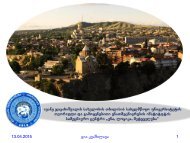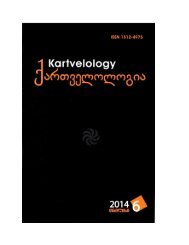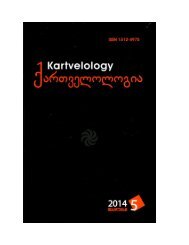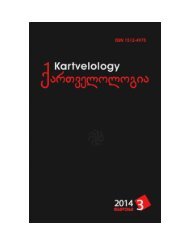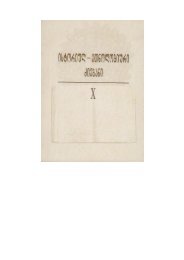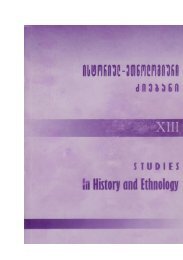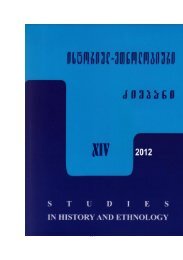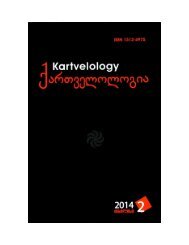Kvashilava, Gia, 2010. On Reading Pictorial Signs of the Phaistos Disk and Related Scripts (2). Rosette (in Georgian and English)
This study concerns the graphic character, symbolic meanings, typological parallels, commentaries and reading of the Phaistos Disk pictorial sign PHD38.
This study concerns the graphic character, symbolic meanings, typological parallels, commentaries and reading of the Phaistos Disk pictorial sign PHD38.
You also want an ePaper? Increase the reach of your titles
YUMPU automatically turns print PDFs into web optimized ePapers that Google loves.
Sumerian script signs: , (Mercer 1918, 9; Falkenste<strong>in</strong><br />
1936, 44, 45a, 47, 193); ;<br />
<strong>Signs</strong> <strong>of</strong> cuneiform script 1 : , (Falkenste<strong>in</strong> 1936, 192)<br />
used dur<strong>in</strong>g 3200-3100 BC <strong>in</strong> <strong>the</strong> Late Uruk IV period;<br />
, used dur<strong>in</strong>g 3100-3000 BC <strong>in</strong> <strong>the</strong> Jemdet Nasr period<br />
(or <strong>the</strong> Late Uruk III period) on <strong>the</strong> follow<strong>in</strong>g clay tablets:<br />
Ashm-1926-714, CDLI No P005249; Ashm-1926-709, CDLI<br />
No P005216;<br />
used dur<strong>in</strong>g 2600-2500 BC on <strong>the</strong> follow<strong>in</strong>g clay tablets<br />
<strong>of</strong> <strong>the</strong> Early Dynastic IIIa period: Ashm-1928-017, CDLI No<br />
P005311; Ashm-1928-428, CDLI No P222324; Ashm-1930-<br />
156, CDLI No P220624, <strong>and</strong> – on <strong>the</strong> follow<strong>in</strong>g clay tablets:<br />
Ashm-1924-0455, CDLI No P222314; MRAH-0.0089, CDLI<br />
No P010548;<br />
used dur<strong>in</strong>g 2500-2350 BC <strong>in</strong> <strong>the</strong> Early Dynastic IIIb<br />
period on <strong>the</strong> follow<strong>in</strong>g clay tablets: Erm-14376, CDLI No<br />
P222695; MRAH-0.0023, CDLI No P222342; MRAH-0.0023,<br />
CDLI No P222946, <strong>and</strong> – on <strong>the</strong> follow<strong>in</strong>g clay tablets: Ashm-<br />
1924-0462, CDLI No P222315; Erm-14065, CDLI No P222280;<br />
Erm-14314, CDLI No P222479; Erm-14012, CDLI No P221719;<br />
1 . Cuneiform signs were called mismari by <strong>the</strong> people liv<strong>in</strong>g <strong>in</strong> Mesopotamia<br />
(<br />
) (Doblh<strong>of</strong>er, Friedrich 2002, 95). I am thankful to<br />
N. <strong>Kvashilava</strong> for draw<strong>in</strong>g my attention to this fact.<br />
Comp. mismari: Arabic [mismari] > Old <strong>Georgian</strong><br />
[lusmari] (Orbeliani 1991, I, 424); M<strong>in</strong>grelian / [lismari/<br />
ləsmari] – nail (Kajaia 2008, II, 92, 93, 195); comp. also: German Keilschrift;<br />
<strong>English</strong> cuneiform (i.e. wedge-shaped) writ<strong>in</strong>g; cuneiform < Lat<strong>in</strong><br />
cŭneus – nail, wedge (Hunt<strong>in</strong>g 1915, 28; Tatishvili 2009, 17 2 ).<br />
Cuneiform sign <strong>in</strong> Sumerian [saĝ.KAK], [saĝtak], , ,<br />
[santak (2,3,4) ] is triangle, wedge (PSD; Halloran 2006, 54), <strong>and</strong> <strong>in</strong> Akkadian<br />
sa·an·tak·ku ( [SAG.DÙ]) – triangle (CAD 1984, 6, 149, 150; also<br />
see: Tatishvili 2009, 17 3 ; Kogan, Loesov 2009, 174); <strong>the</strong> word was used as a<br />
geometric term <strong>in</strong> old Babylon.<br />
244




